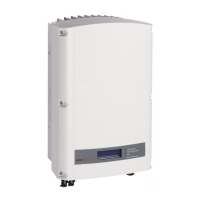Step 3, Connecting Power Optimizers in Strings
You can construct parallel strings of unequal length, that is, the number of power optimizers in each string
does not have to be the same. The minimum and maximum string lengths are specified in the power
optimizers' datasheets. Refer to the SolarEdge Site Designer for string length verification.
1 Connect the Minus (-) output connector of the string’s first power optimizer to the Plus (+) output
connector of the string’s second power optimizer.
2 Connect the rest of the power optimizers in the string in the same manner.
Figure 2: Power optimizers connected in series
3 If you intend to monitor the installation, using the SolarEdge monitoring portal, record the physical
location of each power optimizer, as described in Providing Installation Information on page 27.
Step 4, Verifying Proper Power Optimizer Connection
After a module is connected to a power optimizer, the power optimizer outputs a safe voltage of 1V.
Therefore, the total string voltage should be equal to ~1V times the number of power optimizers
connected in series in the string. For example, if 10 power optimizers are connected in a string, then 10V
should be produced.
Make sure the modules are exposed to sunlight during this process; otherwise, the power optimizers
may not be powered. If you use a tracker, the power optimizer will turn ON only if the tracker is
tracking the sun and the module provides at least 2W.
In SolarEdge systems, due to the introduction of power optimizers between the PV modules and the
inverter, the short circuit current I
SC
and the open circuit voltage V
OC
hold different meanings from
those in traditional systems. For more information about the SolarEdge systems’ string voltage and
current, refer to the V
OC
and I
SC
in SolarEdge Systems Technical Note, available on the SolarEdge
website at:
http://www.solaredge.com/files/pdfs/isc_and_voc_in_solaredge_sytems_technical_note.pdf
Isolation measurement using a measurement device of up to 1000V is acceptable.

